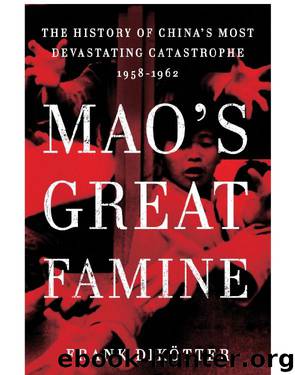Mao's Great Famine: The History of China's Most Devastating Catastrophe, 1985-1962 by Frank Dikötter

Author:Frank Dikötter [Dikötter, Frank]
Language: eng
Format: epub, mobi
Publisher: Walker Books
Published: 2010-09-23T04:00:00+00:00
As cash lost its purchasing power, ration coupons became a form of surrogate money. They were required for most essential goods, ranging from oil, grain, pork and cloth to thermos flasks, furniture and even building materials. Designed to ensure equitable distribution of basic commodities, they also tied the population into the household system, through which they were distributed. Each household was issued with a certificate or ration book on which all the family members were recorded, and this document in turn entitled the household to a monthly supply of ration coupons. Coupons were often valid for only one month. Their use was sometimes restricted to their place of issue, which could be a local canteen, a commune, a county, a city or occasionally an entire province. A rice coupon from one county had no validity in the next, forcing people to stay in their place of residence.32
Coupons were traded, just as goods were bartered. In some communes, for instance in Jinghai county, Hebei, coupons became a substitute for salaries, as money was all but phased out. A huge variety of coupons for goods and services from pumpkin seeds to haircuts was issued in lieu of payment, ranging in value from one fen to five yuan.33
One of the purposes of coupons was to preclude hoarding. But as the Guangdong Provincial People’s Congress discovered in February 1961, over a third of all coupons, distributed since September 1959, had not been exchanged, meaning that paper worth some 20,000 tonnes of grain was circulating as surrogate money.34
Forging coupons, which were often hastily printed on poor-quality paper, was much easier than counterfeiting money. In the East China Hydraulic Institute a dozen forgeries circulated in the canteens.35 The phenomenon must have been common. A police raid in Shantou brought to light some 200 separate cases involving pirated coupons. As a report to the provincial People’s Congress indicated, more than a third of social infractions were related to ration coupons; the security forces even blamed ‘enemy speculators’ for releasing a flood of fakes in Qingyuan in the autumn of 1960.36
Download
Mao's Great Famine: The History of China's Most Devastating Catastrophe, 1985-1962 by Frank Dikötter.mobi
This site does not store any files on its server. We only index and link to content provided by other sites. Please contact the content providers to delete copyright contents if any and email us, we'll remove relevant links or contents immediately.
| Africa | Americas |
| Arctic & Antarctica | Asia |
| Australia & Oceania | Europe |
| Middle East | Russia |
| United States | World |
| Ancient Civilizations | Military |
| Historical Study & Educational Resources |
The Alienist by Caleb Carr(1542)
The Analects of Confucius by Burton Watson(1145)
On China by Henry Kissinger(1121)
China in Ten Words by Yu Hua(990)
The Last Kings of Shanghai by Jonathan Kaufman(972)
One Bright Moon by Andrew Kwong(865)
Deng Xiaoping and the Transformation of China by Vogel Ezra F(843)
Mao's Last Dancer by Li Cunxin(822)
Three Tigers, One Mountain by Michael Booth(800)
Midnight in Peking by Paul French(797)
Seven Years in Tibet by Heinrich Harrer(793)
The Snakehead: An Epic Tale of the Chinatown Underworld and the American Dream by Patrick Radden Keefe(789)
Big Sister, Little Sister, Red Sister by Jung Chang(742)
Tiger Trap by David Wise(698)
Ancient Chinese Warfare by Ralph D. Sawyer(683)
Modern China. A Very Short Introduction by Rana Mitter(639)
The Open Road by Pico Iyer(631)
Chinese Theology by Chloë Starr(626)
Riding the Iron Rooster by Paul Theroux(617)
